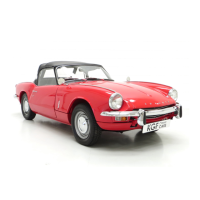DRIVING FROM NEW
26
DRIVING FROM NEW
Starting the Engine from Cold
Check, and if necessary top up, the radiator water level and the
engine oil level. If the car has not been used for several days and
fuel has evaporated from the carburettors, refill them by operating
the priming lever on the fuel pump. The slight resistance ceases
when the float chambers are full.
Apply the handbrake and ensure that the gear lever is in
"Neutral". In cold weather pull the choke control fully out; in warm
weather pull to the mid-position. In hot climates, do not use the
choke. Insert the ignition key and turn it to the "Ignition" position,
causing the ignition warning light to glow and the fuel gauge to
register the contents of the fuel tank.
From the "Ignition" position, turn the key clockwise against
spring pressure to operate the starter motor. Immediately the engine
fires, release the key, which will return to the "Ignition" position.
Should the engine fail to start at the first attempt, do not re-operate
the starter switch until the starter motor has come to rest.
As soon as the engine starts, push the choke control "half in"
(cold climates), or fully in (warm climates) and warm the engine at
an idling speed of approximately 1,500 r.p.m. This will cause the
ignition and oil pressure warning lights to be extinguished, thus
indicating satisfactory performance of the generating and lubricating
systems. Should either warning light remain on, stop the engine and
establish the cause. Failure to do so may result in serious damage
to the engine.
After starting the engine, cylinder wear is minimised if the
engine is warmed up quickly by driving away when the oil
pressure warning light is extinguished. Do not race the engine to
speed up the process but, if possible, maintain an engine speed of
approximately 1,500 r.p.m. until the choke can be pushed fully in.
In warm climates, use of the choke may be unnecessary. Avoid the
use of full throttle during the warming-up period. A thermostat
incorporated in the cooling system enables the engine to be
warmed up quickly from cold.
Starting with the Engine Warm or Hot
When re-starting a hot engine, depress the accelerator pedal to
about one-third of its travel before operating the starter switch.
The choke control should not be used.
Running-in
The importance of correct running-in cannot be too strongly
emphasized, for during the first 1,000 miles (1,600 km.) of
motoring, the working surfaces of a new engine are bedding
down.
During this period the valve seats stabilise causing, in some
instances, slight distortion and preventing proper seating of a

